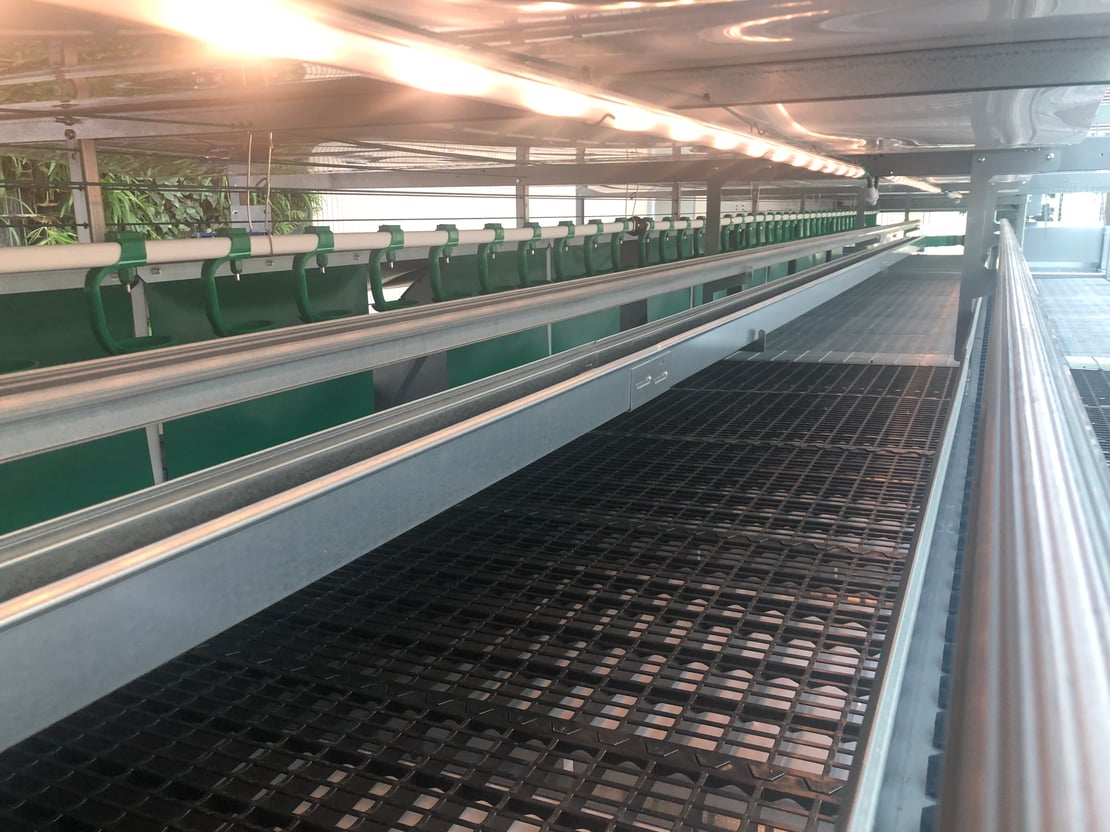"Chickens can also perceive light through their skulls, so even a 'blind' chicken can sense the length of daylight periods and thus seasonal changes. Good lighting is especially important for poultry."
 Bas Liebregts, Product Manager at Vencomatic Group, introduces the possibility to install 48 volt lighting in our systems. According to Bas, this makes installation much easier: "At 24 volts, 18 LED lamps can be linked together, at 48 volts this can be up to 50 lamps. This saves on installation costs and we can always place the power supplies outside the bird areas. The 0-10 volt power supplies are also dimmable, which is the standard control in our sector.”
Bas Liebregts, Product Manager at Vencomatic Group, introduces the possibility to install 48 volt lighting in our systems. According to Bas, this makes installation much easier: "At 24 volts, 18 LED lamps can be linked together, at 48 volts this can be up to 50 lamps. This saves on installation costs and we can always place the power supplies outside the bird areas. The 0-10 volt power supplies are also dimmable, which is the standard control in our sector.”
Why is lighting important for poultry?
"With lighting you simulate nature. We do this as good as possible in our systems and give advice on the total lighting plan of the house. At Vencomatic Group we do not supply products, we solve the farmer's problem. Lighting is very important in this."
"When it comes to lighting in a poultry house, intensity and light distribution are especially important. It is important that there are no large contrasts between light and dark in the house, because if a chicken sees a dark corner, there is a chance she will lay an egg there.”
“Integrated into our lamps is a special diffuse foil that ensures optimum light distribution. This way we get a correct and equal light intensity at animal level, 30-35 lux per hen is enough. We fix the lamp to our system, so that the tubes cannot twist. This way we know for sure that the light display does not change.”
What else should you pay attention to when lighting in a poultry house?
"The light spectrum is also very important; it is the part of the electromagnetic spectrum that is visible to a chicken. What a chicken sees is different from what a human sees. We take that into account in our lighting, we follow the spectrum that the chicken sees."
"What also needs to be considered, is that light is dimmable from 100% to 0% to simulate sunset, so you can lure the animals back into the system. The chicken then senses that it needs to go to bed."
"In nature, when the sun goes down, the hen goes to find a safe sleeping place in the tree. This is its natural behaviour. With the lighting in the house we mimic this and the hen goes up in the system looking for a place to sleep. This also prevents floor eggs, so we kill two birds with one stone. Not literally of course.”
So you should try to follow nature?
"Indeed. Colour temperature, or Correlated Colour Temperature (CCT), is also important. The lower the colour temperature, the warmer the light. That sounds contradictory, but have you ever heard of 'white hot'? That's where the word comes from. Colour temperature is expressed in the number of degrees Kelvin, which indicates the relationship between the temperature of a piece of metal and the light it emits. Our lamps emit a warm white colour, which most closely matches the spectrum present in nature during sunrise and sunset, a very calm colour temperature."
"The light in a poultry house should not flicker either, you don't want a strobe effect. However, as a human being you can't always judge this properly: a human can detect flickering up to 30 kHz, but a chicken can detect up to 200 kHz. The wrong lights can create a restless environment, so we make sure our lighting meets that 200 kHz."
How do we help farmers with lighting in their poultry houses?
"We advise farmers based on a lighting plan. This describes the position of the lamps, the desired intensity at animal level and a lighting programme. This is because you have to adjust the lighting to the daily activities for optimal results, such as when to feed and when to open and close nests."
“Light is an important part of creating a good environment for the chicken and for our customers to be able to present themselves well.”
Check out our Vencomatic House Lighting - the perfect lighting solution for optimal bird health and farm efficiency.












.png?width=160&height=132&name=Egg%20packers%20-%20Vencomatic%20Group%20(2).png)
.png?width=160&height=132&name=Meggsius%20Select%20-%20Vencomatic%20Group%20(2).png)













